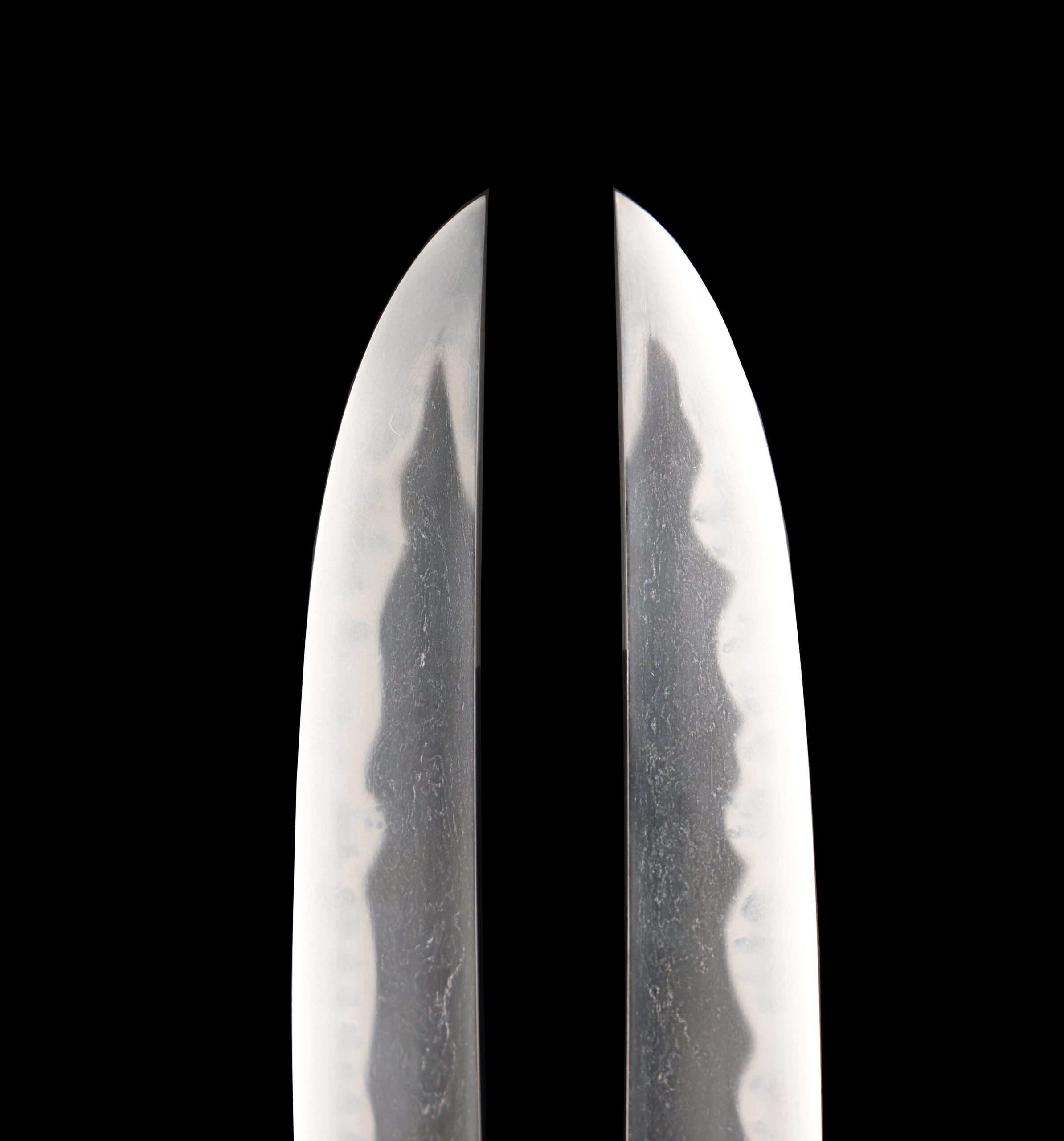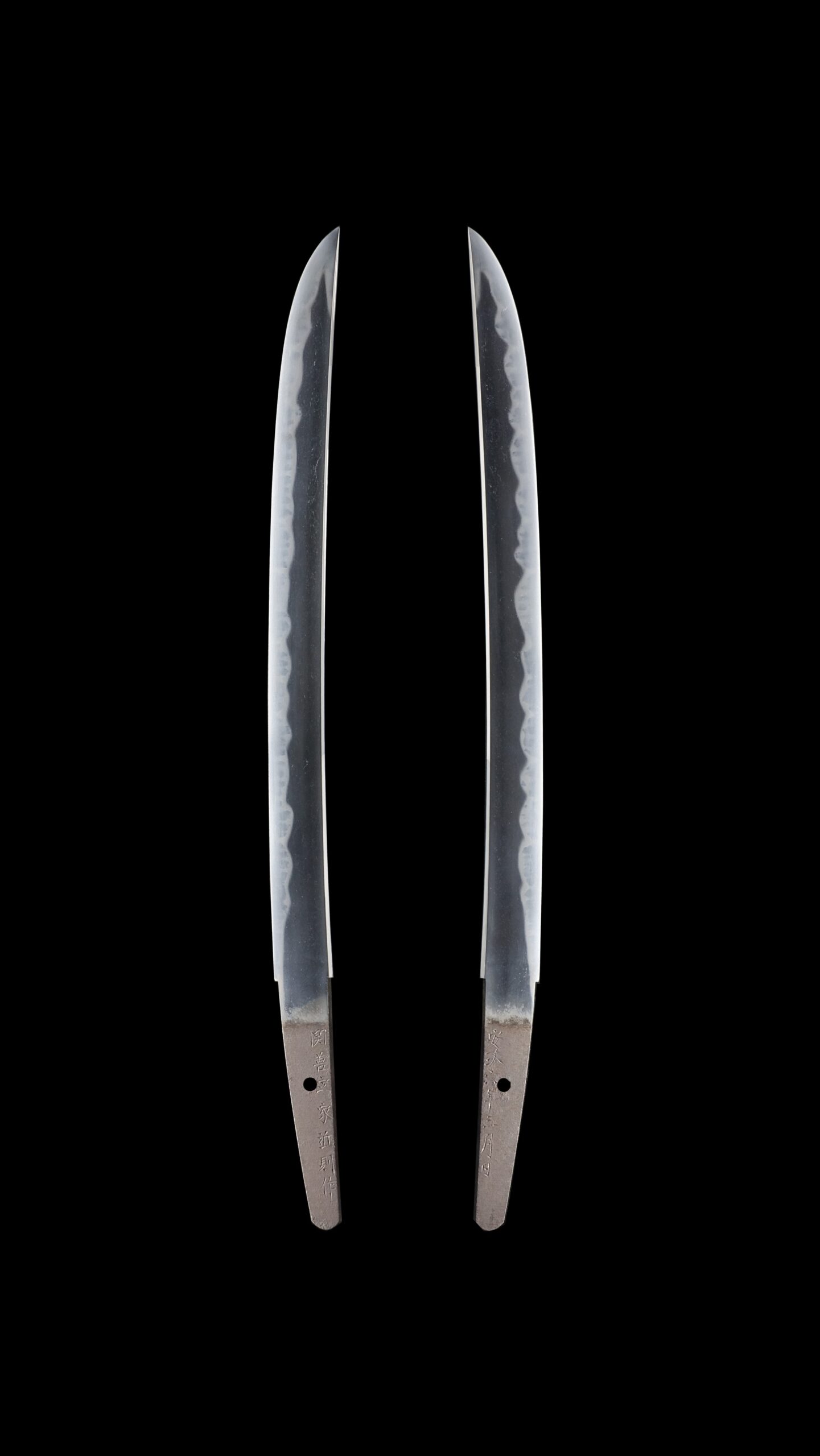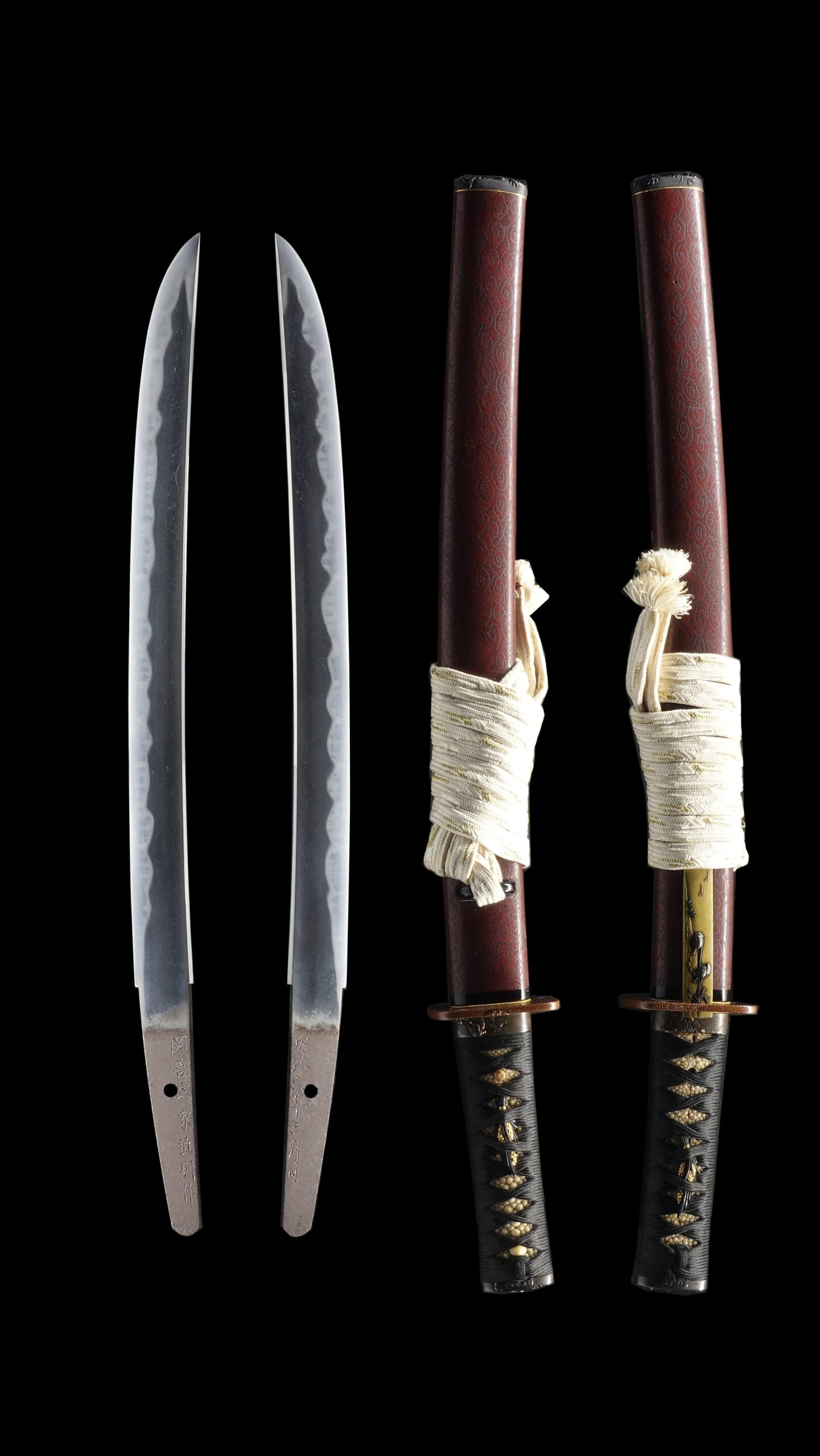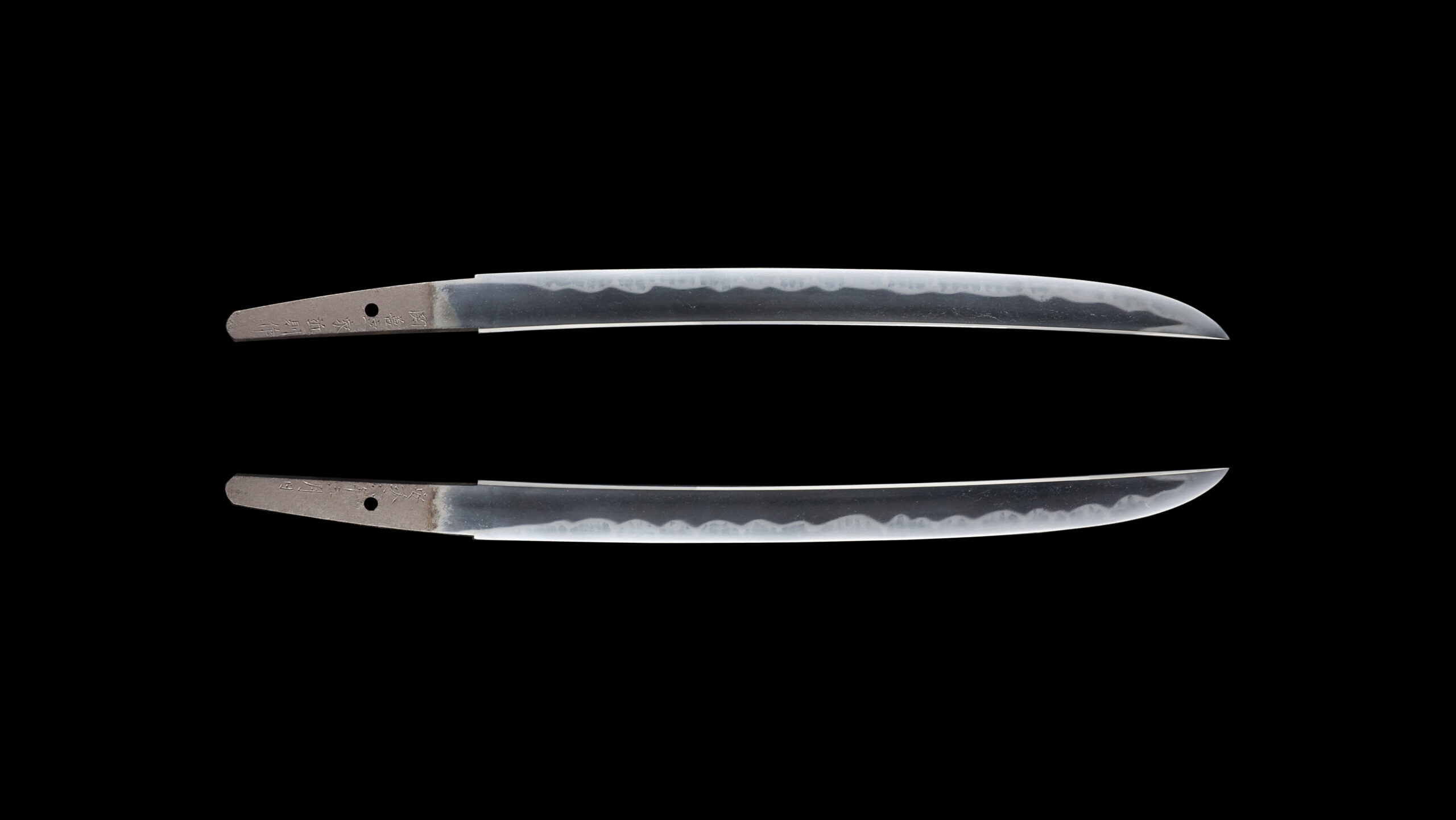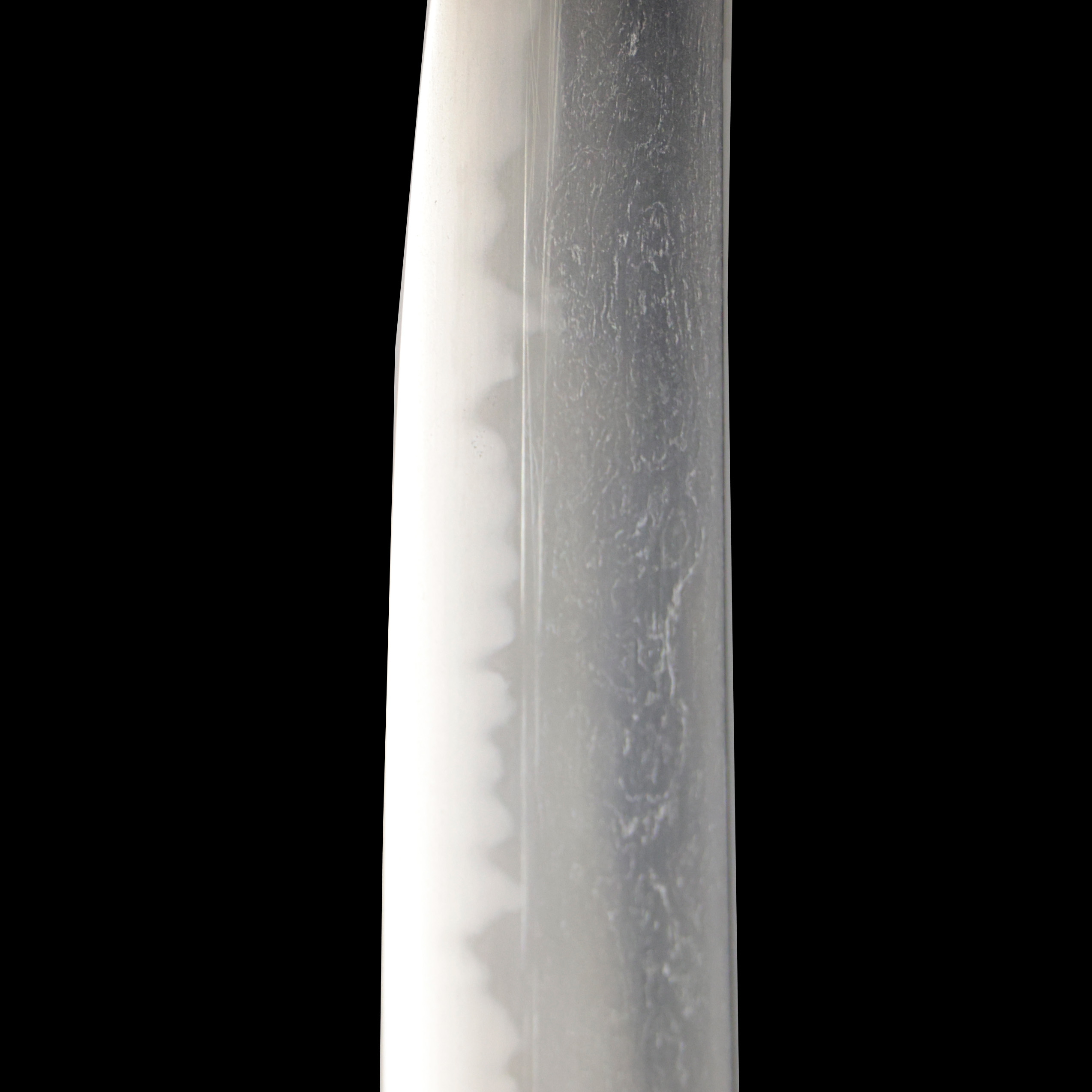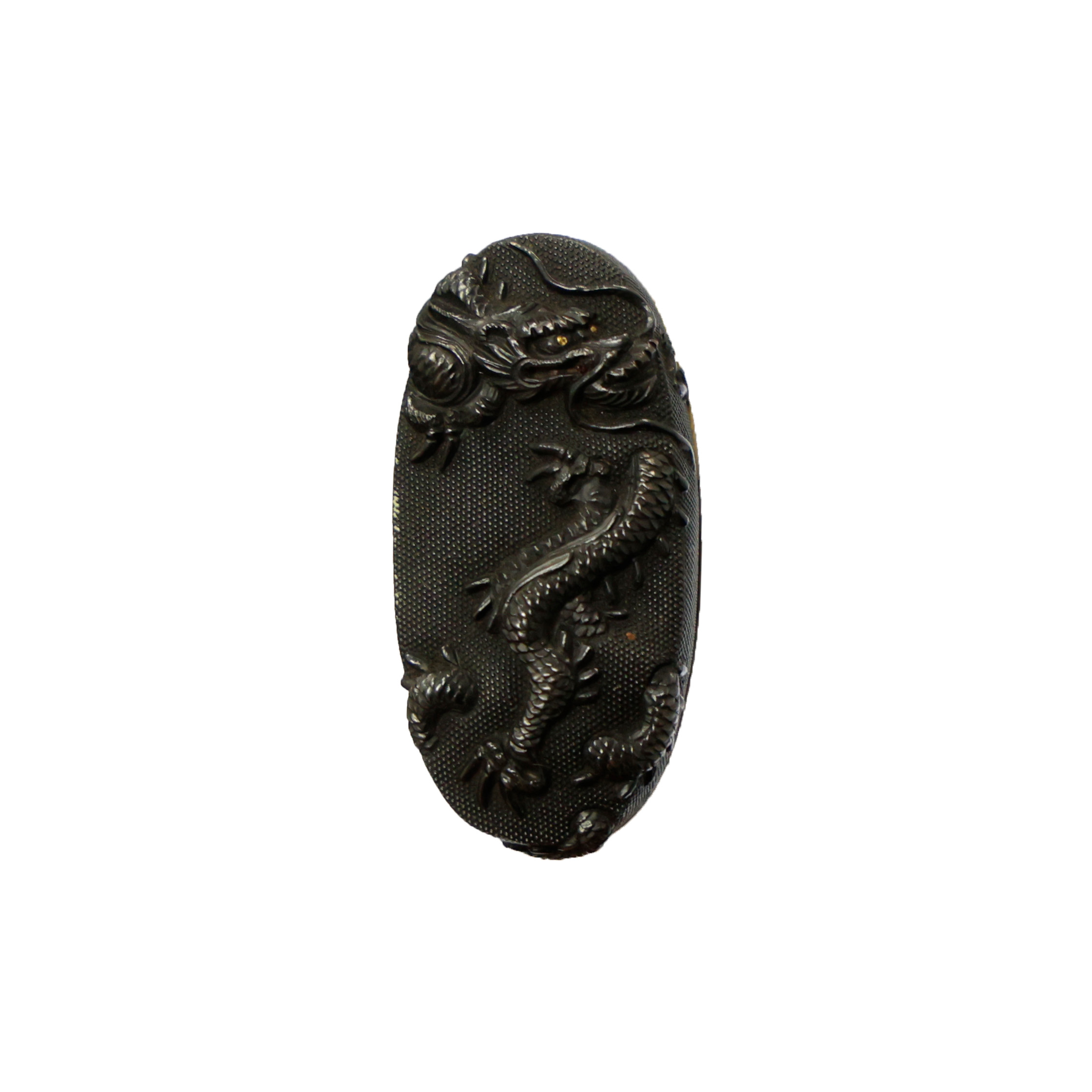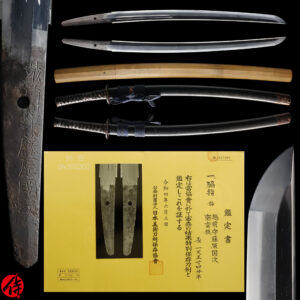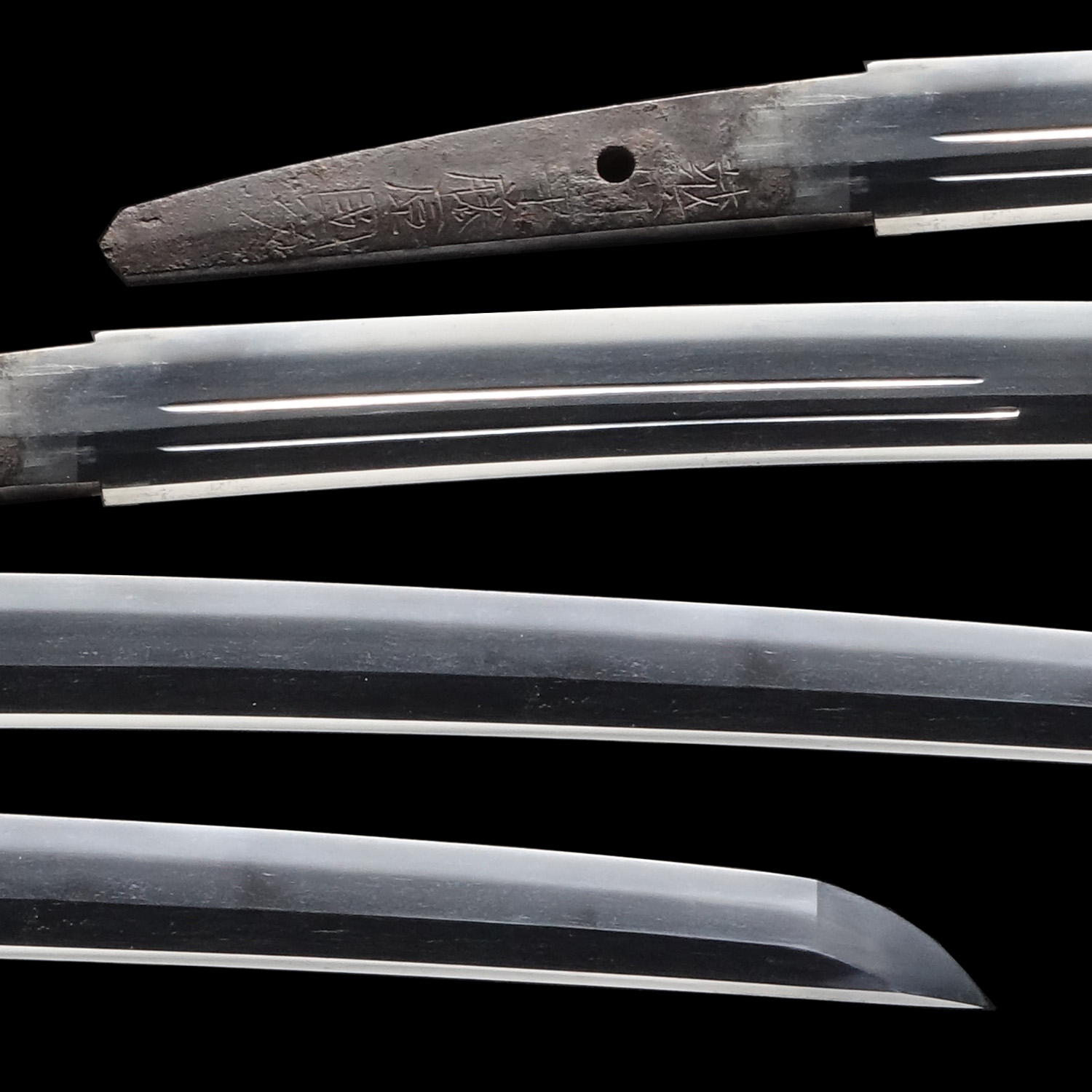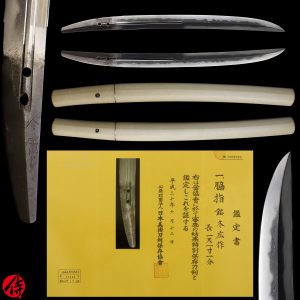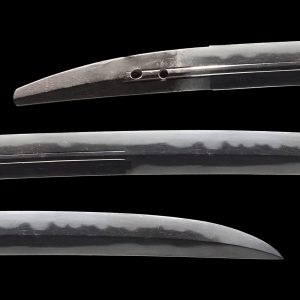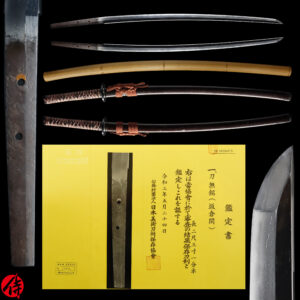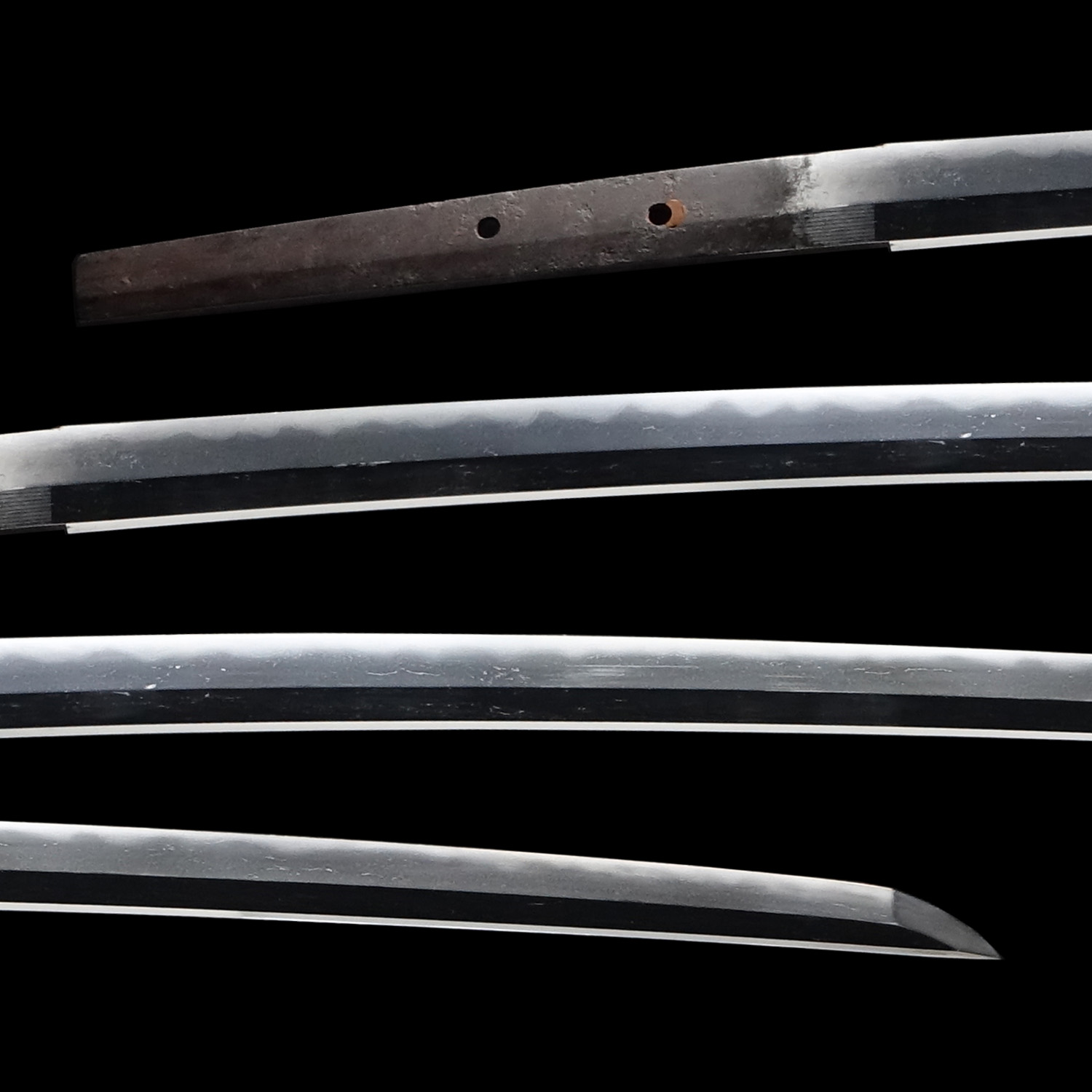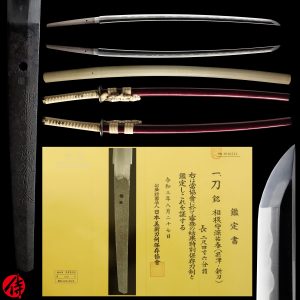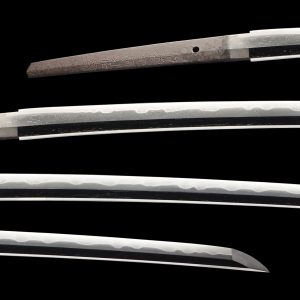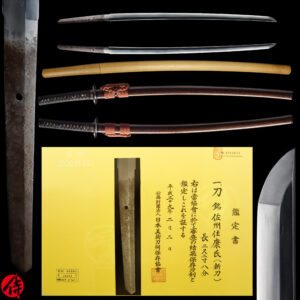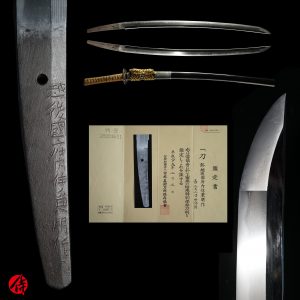Antique Japanese Sword Wakizashi Signed by Chikanori with NBTHK Tokubestsu Hozon Certificate
【Description】
Summary
This blade was signed by Seki Zenjo Ke Chikanori (関善定家近則) in the sixth year of the Ansei era (1859: the end of the Edo period). Chikanori was active during 1818-1864 (the late Edo period). He was originally from Mino province (today’s Gifu prefecture) and is said to be an offspring of Seki Zenjo Ke, one of the region’s seven most prosperous schools. He signed his ancestor’s name on the signature to show homage.
Chikanori’s birth name was Kikuchi Toyosaburo. He was later adopted by the 5th-gen Kawamura Kansaburo, who lived in Mito province (today’s Ibaraki prefecture). And he changed his maker’s name to Chikanori. He learned the sword-forging technique from Taikei Naotane (大慶直胤), one of the most famous swordsmiths at the end of the Edo period. He improved his craftsmanship significantly under Naotane’s supervision. After finishing the apprenticeship, Chikanori returned to Mito province and became a Hanko, a swordsmith exclusively serving a specific domain or clan. Also, at that time in Mito province, a durability test for swords called Ara dameshi was often conducted to confirm the toughness of swords, such as cutting several rolls of straws with bamboo in it, cutting several iron plates and so on. It is said that only the swords which endured the tests were dedicated to the Mito clan. Therefore, this sword might be the one which endured considerable testing and proved its toughness.
It is said that he was also a Samurai who served Mito province. Mito province was controlled by Tokugawa family and gained political influence. Considering the fact he served this province, his craftsmanship must have been highly appreciated among Samurai there.
Mino Province
The MINO swordsmith style, also known as MINO-DEN, basically has the TOGARI(Pointed shapes protruding from the Hamon )in a classic straight line and random temper line with some white Utsuri. MINO-DEN had its origin in YAMATO-DEN in the late KAMAKURA period(1280-1330). It flourished in the MUROMACHI period (1333-1573) and continued until the EDO period (1603-1868).
MINO-DEN especially prospered during Sengoku Jidai (Warring State period) due to the high demand for weapons. And the location of Mino province beat others. Akechi Mitsuhide controlled Mino province, and Nobunaga Oda ruled Owari province. Tokugawa Ieyasu was the lord of Suruga (Neighboring areas). There was high demand from those powerful feudal lords and their retainers. Furthermore, so many wars occurred between the Kanto region and the Kyoto area.
Mino is located in the middle, making feudal lords feel convenient to order swords from MINO-DEN. The blades forged in MINO provinces also had a reputation of their practical design and sharpness. Many feudal lords demanded swords forged in the Mino province. The tradition of excellent sword forging skills had been passed to the Edo period, and Chikanori is a good example.
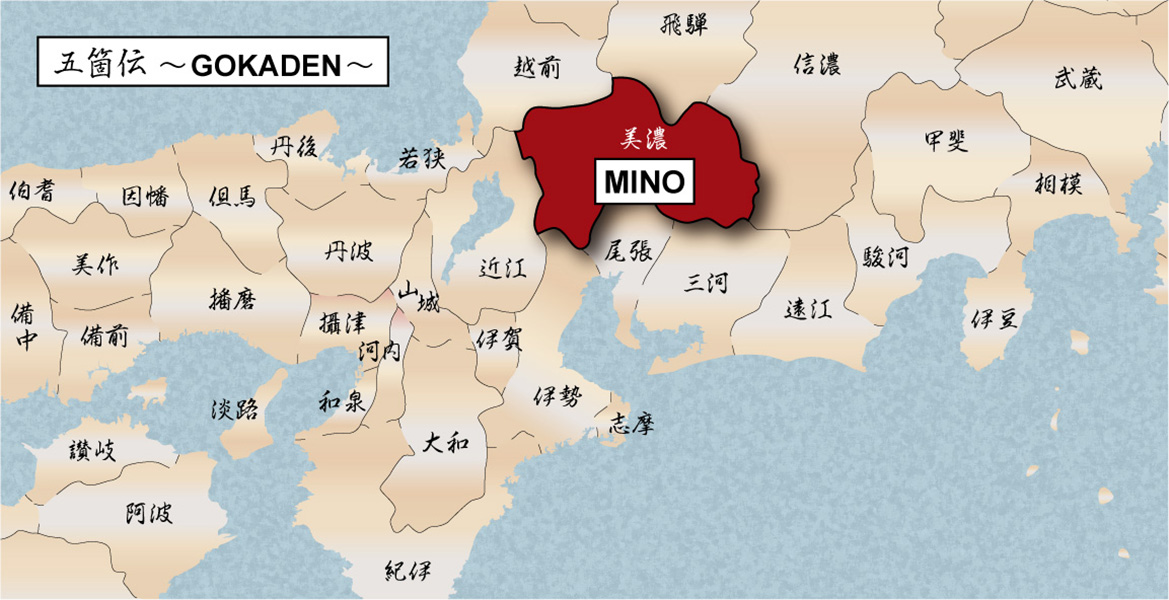

Background
Japan enjoyed a relatively peaceful time from the early Edo period to the mid-Edo period (the 1600s-1760s) because of the stable economy and the powerful government run by Tokugawa Shogun. Samurai didn’t have many opportunities to utilize his Katana sword in public or on battlefields during this time. Thus, they carried their swords more as a symbol of their social status. The demand for weapons decreased accordingly compared to the previous Warring state period called Sengoku Jidai (1467-1600).
However, toward the end of the Edo period (1764-1876), the Japanese sword’s role changed dramatically. With the poverty spreading in Japan, there were so many riots initiated by the civilians. Japanese sword started to play an essential role in maintaining public safety.
Pressure from foreign countries to open Japanese borders also forced Samurai to order strong-looking swords to survive this tumultuous time. We believe many swordsmiths, including Chikanori, made great efforts to forged high-quality, practical blades for their masters to prepare for battles.
There was a civil war between Tokugawa’s military government and the new Meiji government at the end of the Edo period. That means the original owner of this Wakizashi might have seen the moment when Samurai’s life changed forever.
This blade is appraised as a Tokubetsu Hozon Token (特別保存刀剣) issued by NBTHK (Nihon Bijutsu Touken Hozon Kyokai:日本美術刀剣保存協会). This authentication paper was only given to authentic Japanese swords, especially well preserved and high quality with artistic value.
*Please keep in mind that there is visible Hike Kizu (scratch on the blade). If you like to check the detailed condition, please feel free to contact us.
【Blade】
Cutting Edge Length(Nagasa):36.3 cm (14.2 inches)
Curvature(Sori):0.3 cm (0.11 inches)

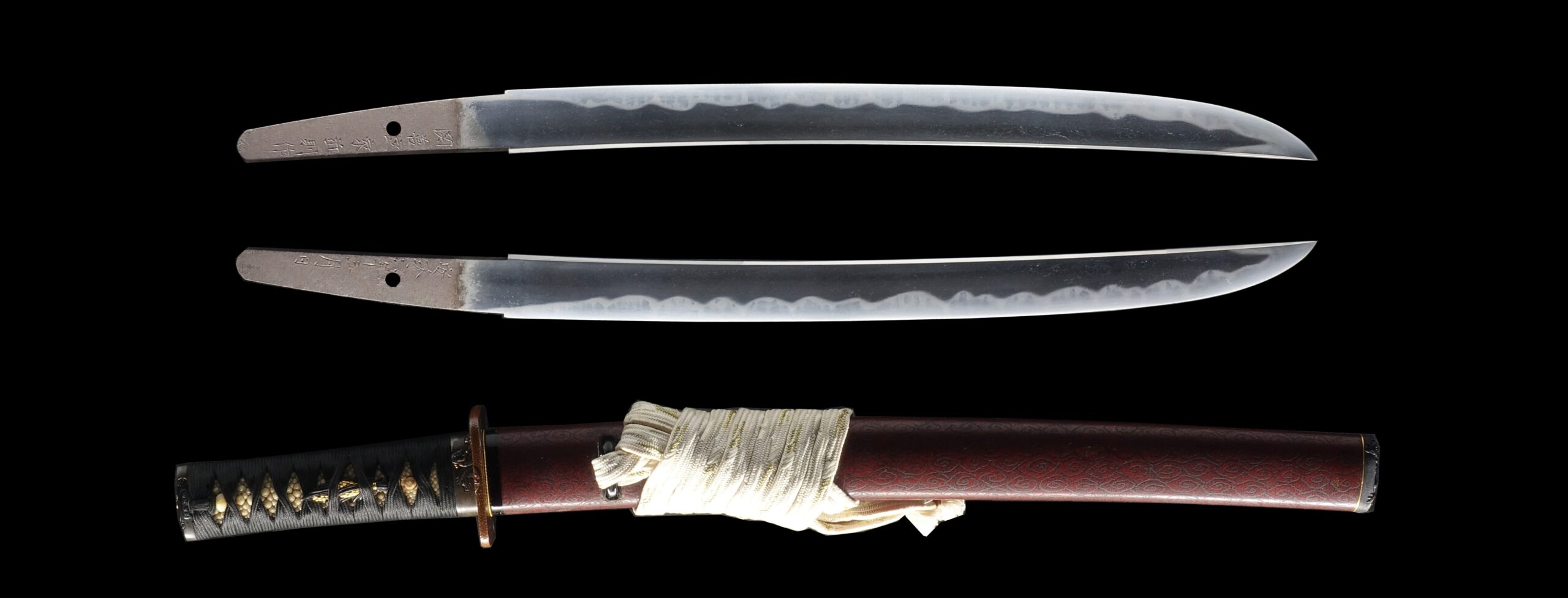
Hamon:
The crystalline structure which forms along the cutting edge of a blade as a result of the hardening process
Jimon(Jihada):
visible steel surface pattern created by folding and hammering during forging process

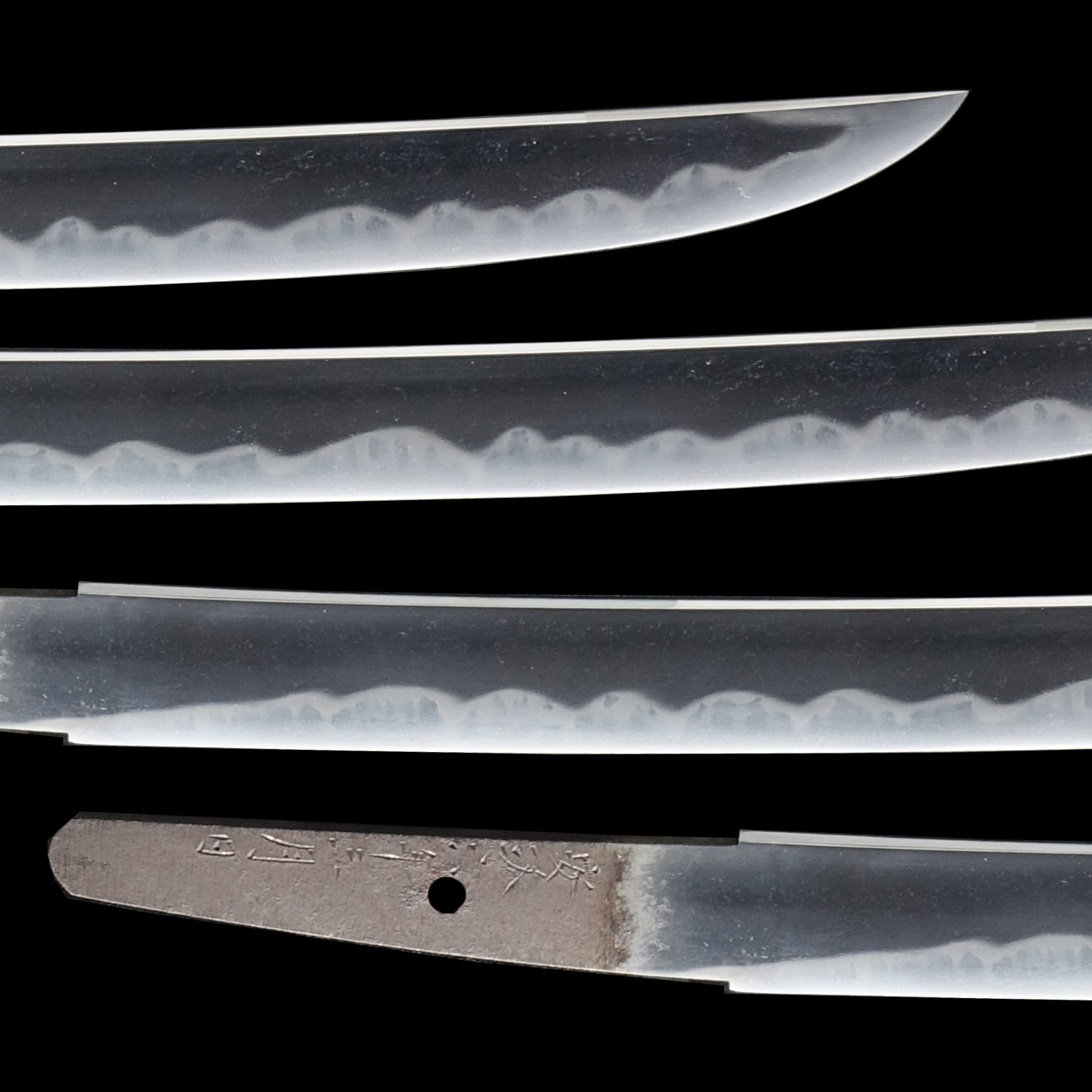

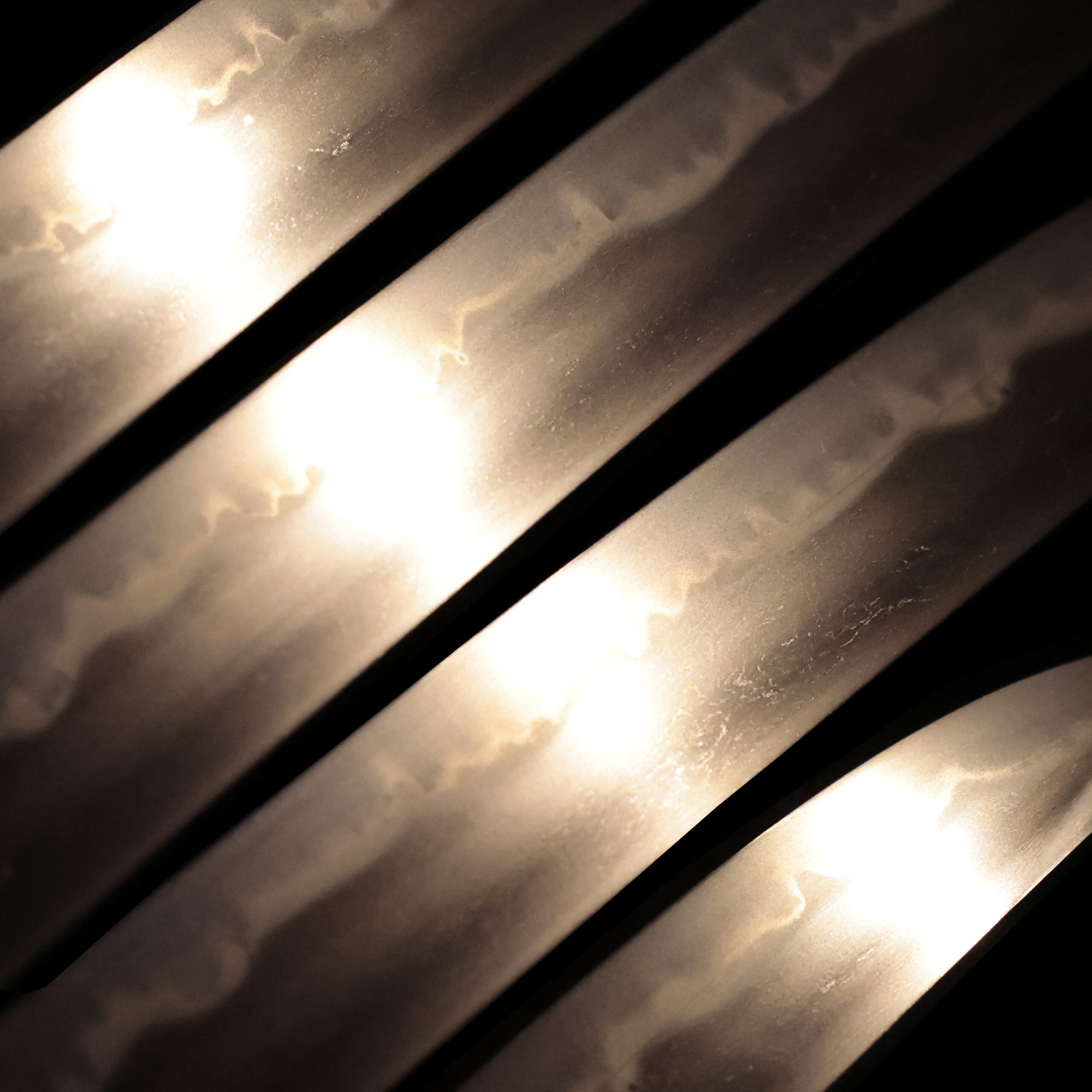
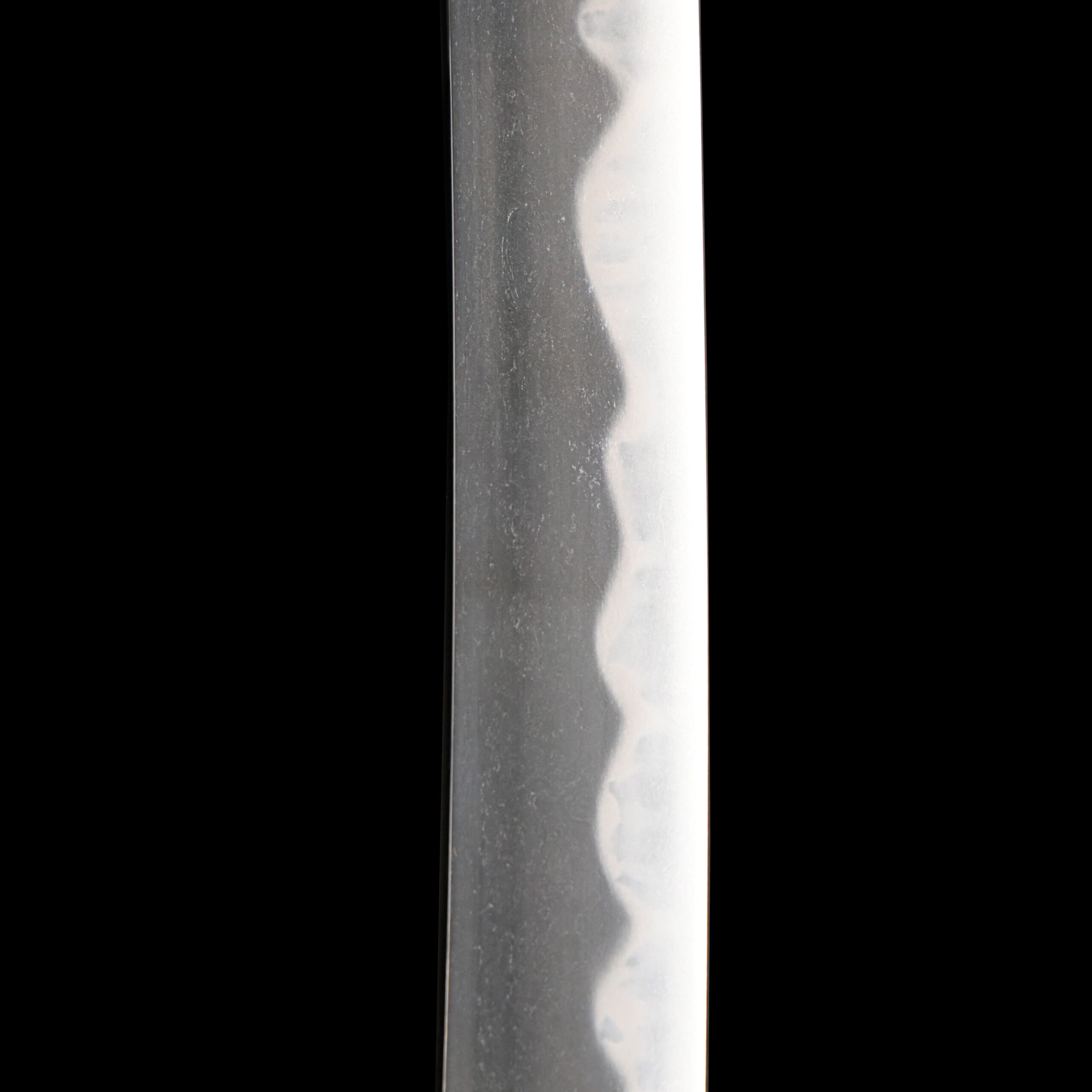
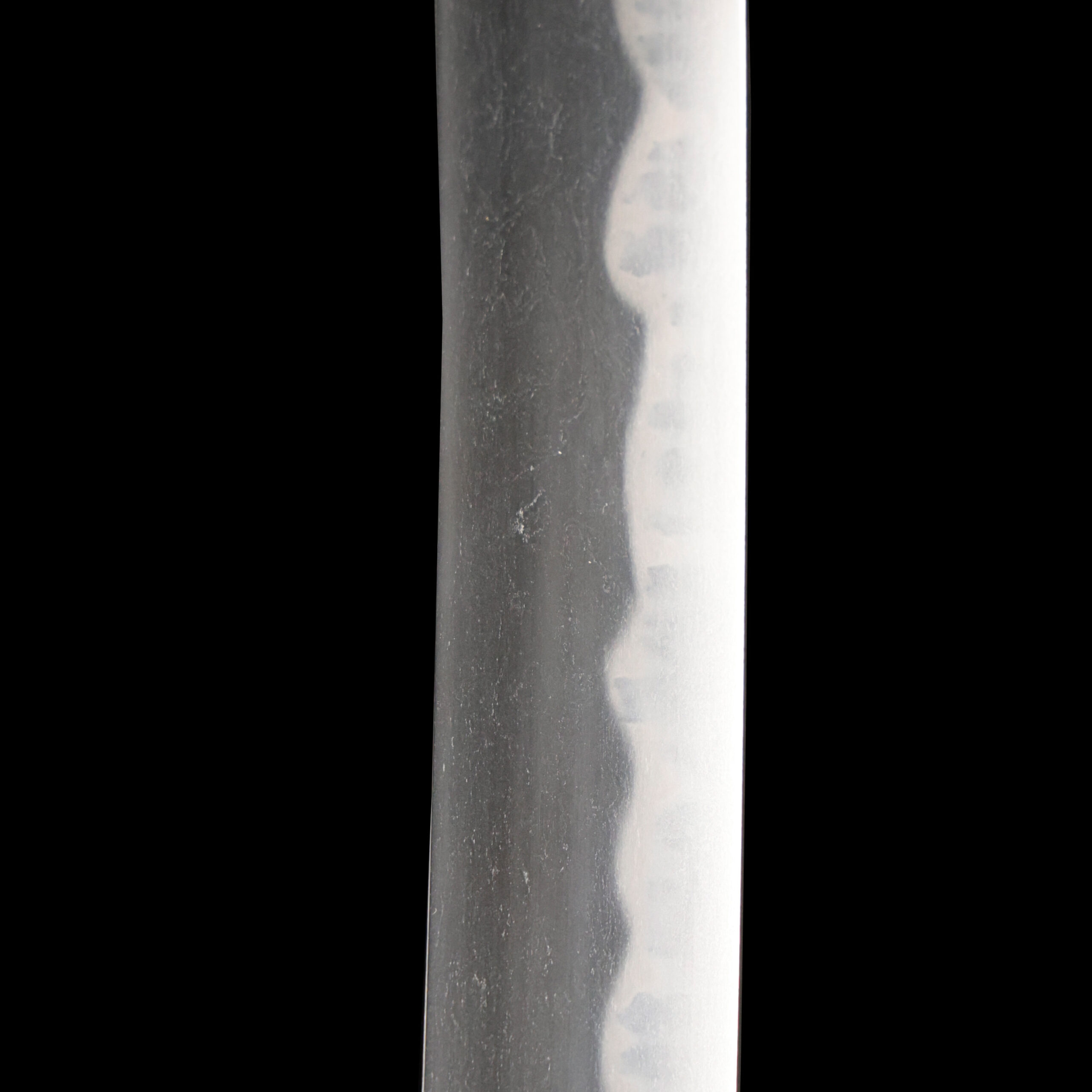
Kissaki:Kissaki is the tip of the Japanese sword.
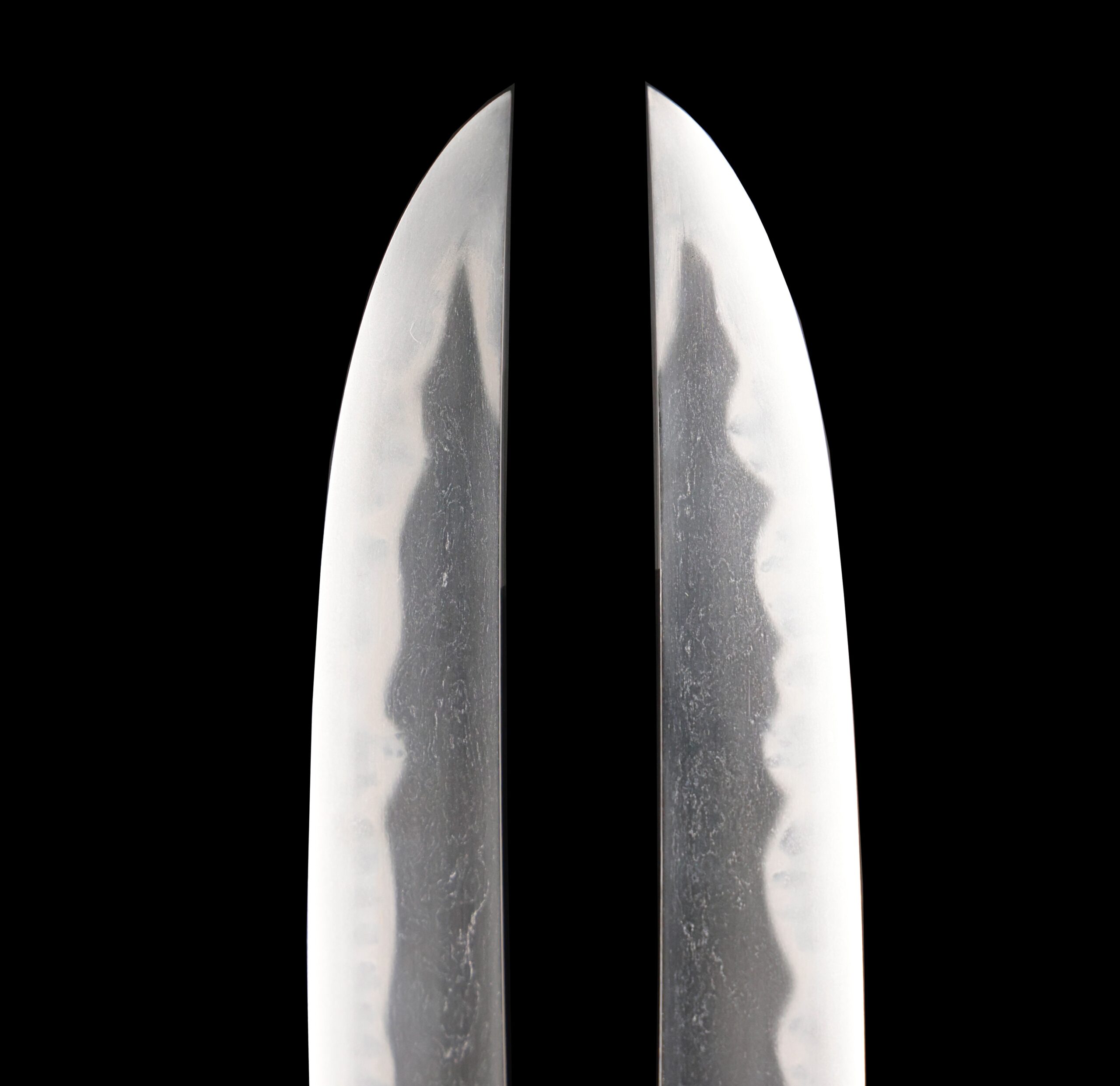
Nakago:Nakago is the tang of the Japanese sword.
Japanese swordsmiths left the black rust on the tang because it prevents red rust while the tang is in its handle. And the discoloration of the tang was created over time, and it is a great indicator for a Japanese sword specialist to estimate when the sword was forged.
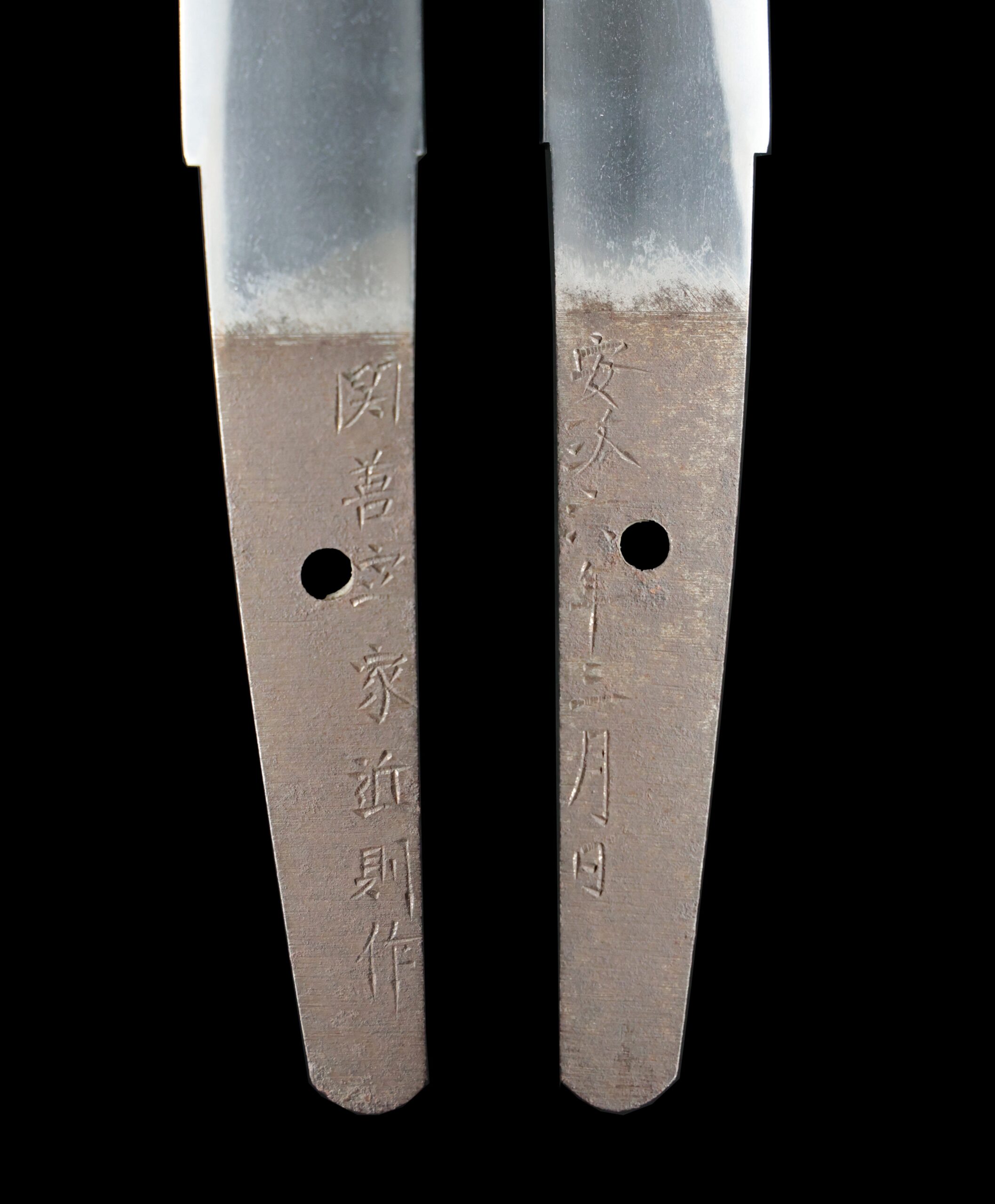
Koshirae:Koshirae is the mounting of the Japanese sword. There are several parts that consist of Koshirae such as Saya (Scabbard), Tsuka (Handle), Tsuba (Handguard).

Fuchi-Kashira:A pair of matching sword fittings that cover the upper and bottom parts of its sword hilt.
You would find a man with a horse on this Fuchi Kashira. We estimate this man is the Toh Jinbutsu (唐人物). Toh (唐, 618-907) is the Chinese dynasty name, and Jinbustu (人物) means person/people. In a broad sense, it refers to foreigners. Certainly, their costumes have an exotic atmosphere.
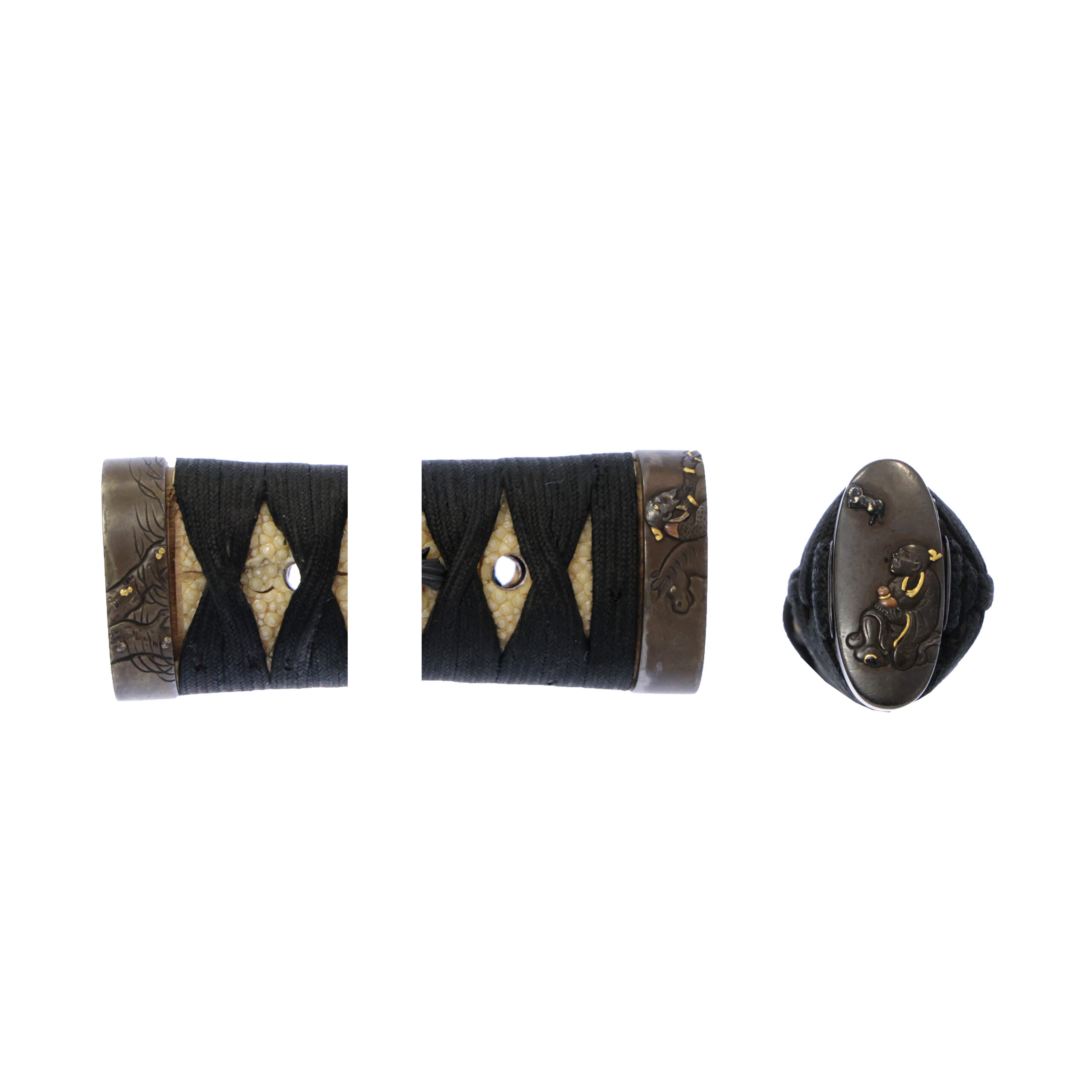
Tsuka and Menuki:Tsuka is the handle of the Japanese sword and Menuki is its decoration.
The motif of this Menuki is Inaho (稲穂, ears of rice). Since ancient times, rice has been worshiped as an essential food and considered a symbol of wealth. In addition, it has been treated like a treasure. Some people believe that god dwells in it. Therefore, the Inaho pattern has often been designed as a crest of the Inari (稲荷) shrine, which enshrines the Inari god, who is regarded as the god of grain and agriculture. Also, this plant motif is seen for family crests. It is one of the familiar designs for Japanese people. This design might have had chosen in the hope of a plentiful harvest and a prosperous life.
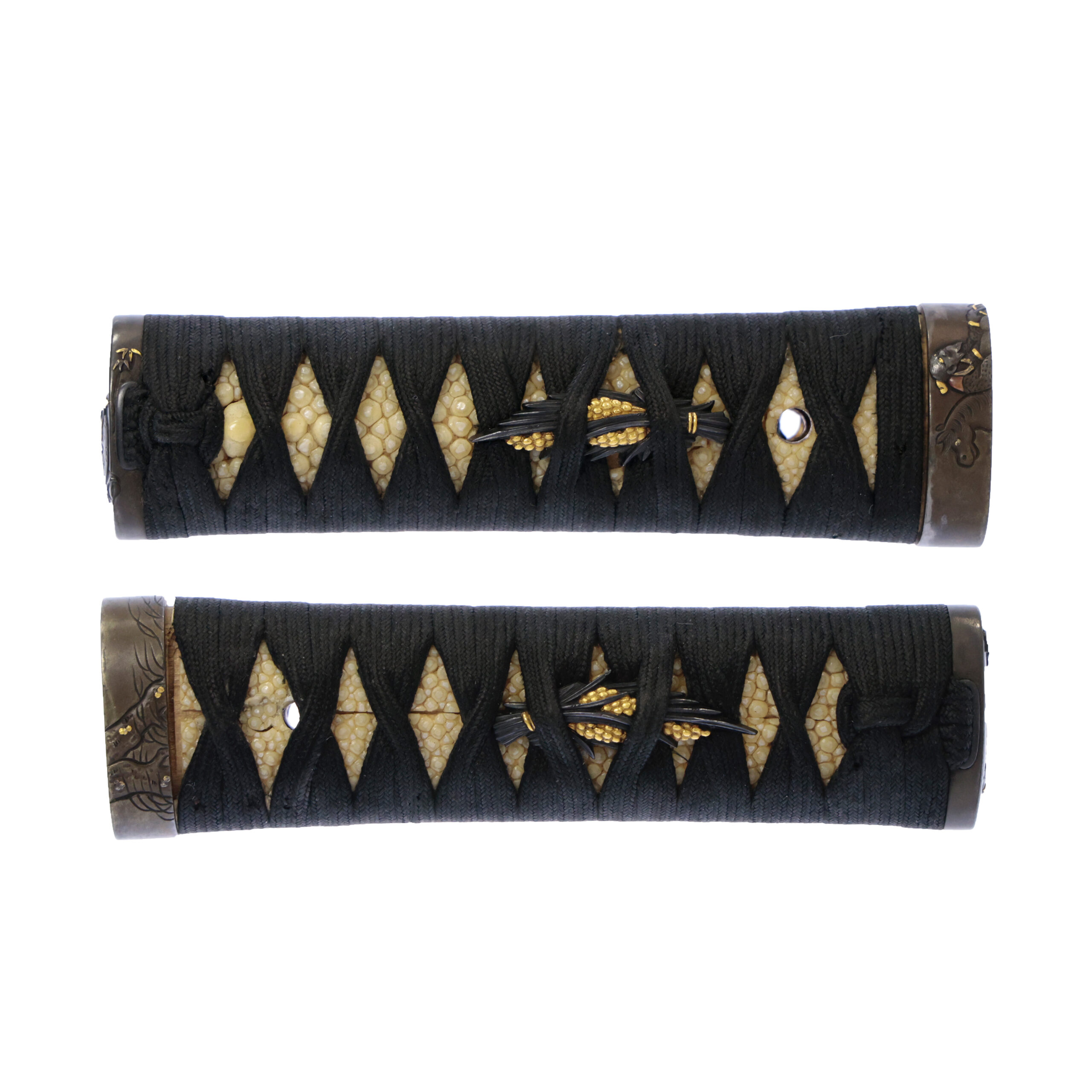
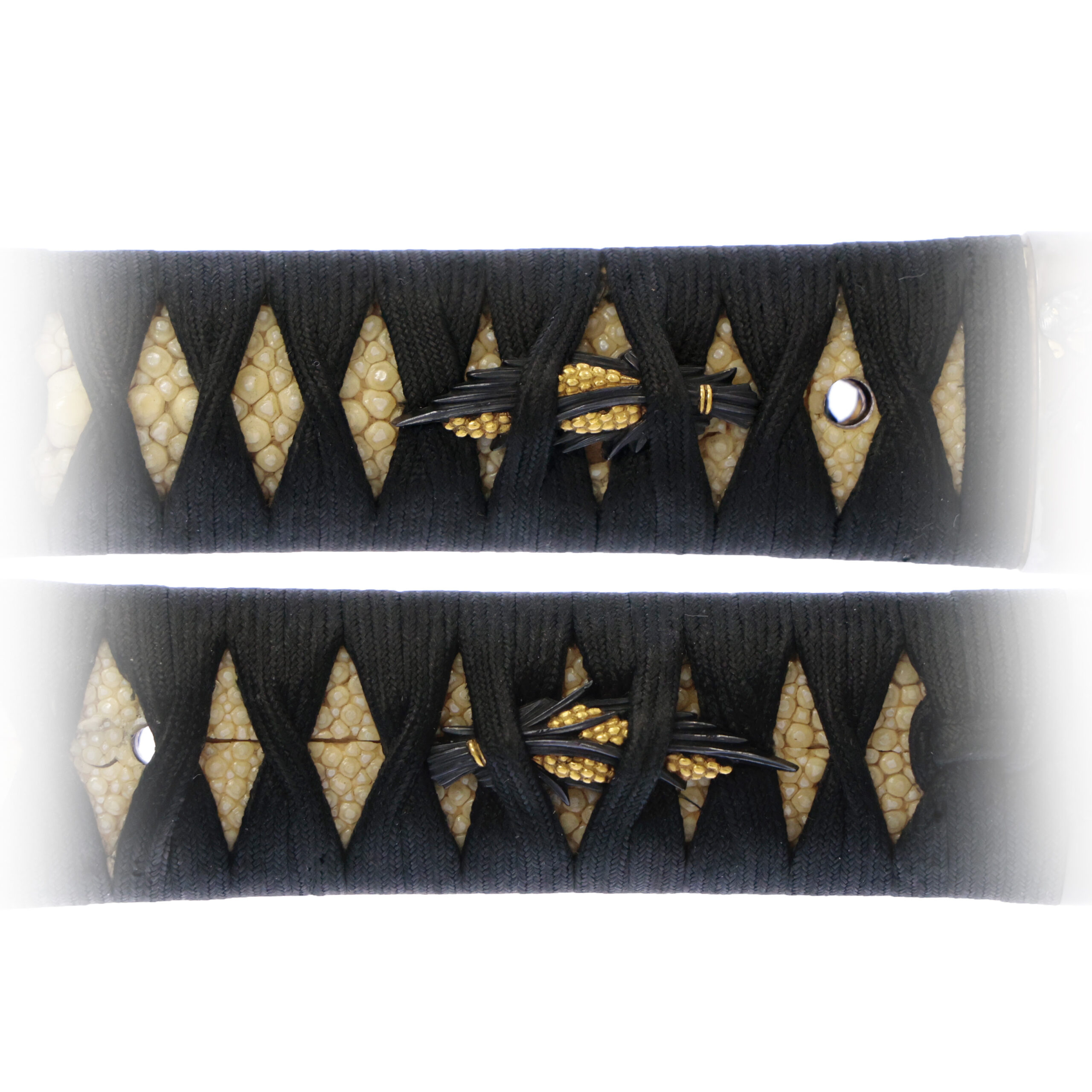
Tsuba and Habaki:Tsuba is the handguard for the Japanese Sword and Habaki is the equipment to make the blade not touch its scabbard inside. It prevents the blade from getting rusty and chipped.
There are several kinds of coin motifs are depicted on this Tsuba. They are, for example, Genpo Tsuho (元豊通宝), Seitsu Waho (政通和宝) and so on. Here, we would like to focus on the Genpo Tsuho, which was the old coin which began to be issued in 1078 in China. Genpo is the era name of China. However, at the end of the Ming Dynasty (around the mid 17th century), there was a shortage of coins in China. Then, it was decided to mint coins with the names of Genpo Tsuho in Nagasaki in Japan to be exported to China for the trading purpose. Therefore, these coins were also known as Nagasaki trade coins. Although they were minted for trading purposes, it is said that they were also used in Japan.
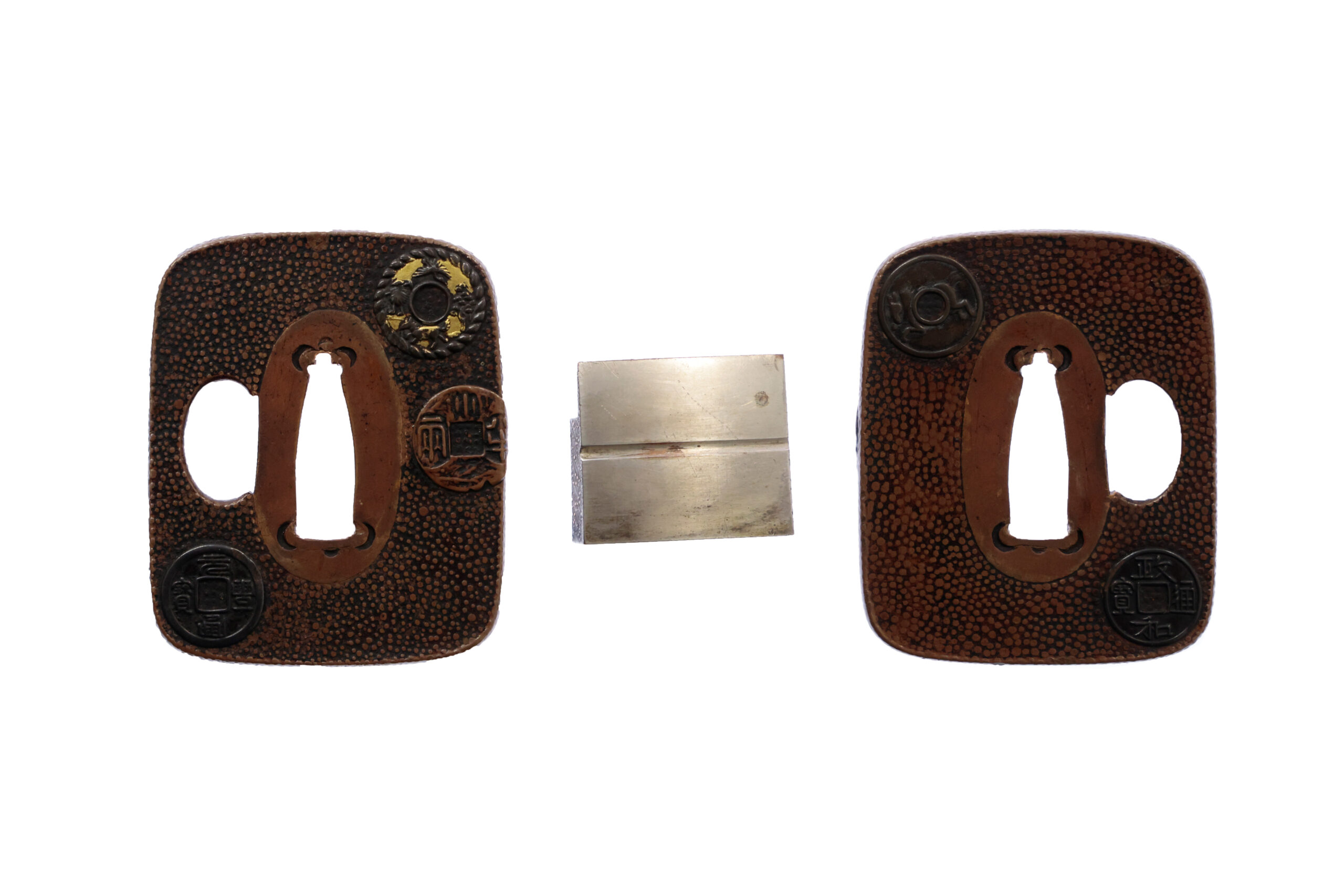
Kozuka:Kozuka is a small knife stored in Kozuka Hitsu(groove of the sheath of the Japanese sword).
The theme of this Kozuka is the Hikibune (曳船/引船, pulling a boat), a design of people pulling a rope to pull a boat. It is interesting that this design is depicted on both the front and back sides. Since Japan is surrounded by the sea, people have had a deep connection with the sea, and various ship-related designs have been created.
Also, you would find the alighting birds, which might be Kari (雁, wild goose), on the front side. The wild goose is a migratory bird, arriving in Japan in autumn to overwinter and returning to the north in the spring. Therefore, it represents autumn. In addition, because of its unique call, Kari is known as “a bird that carries good luck and good news,” meaning that it carries a message with its ancestors and brings good news. This bird was incorporated into designs for sword mountings and family crests as well. We would say this bird motif has been familiar to Japanese people since ancient times.
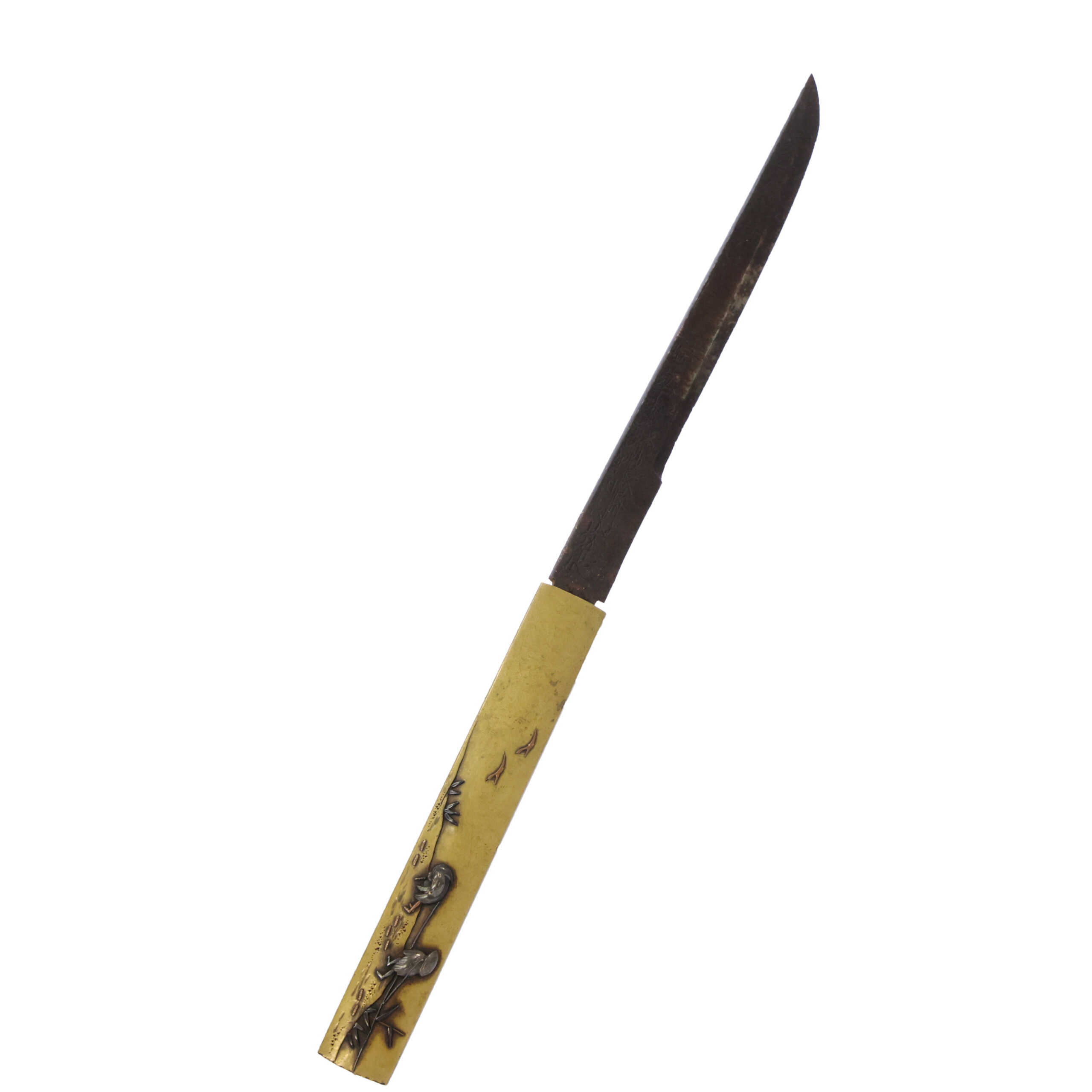

Saya:Saya is the scabbard for the Japanese sword.
On the Kojiri, the head of Saya, a dragon (龍, Ryu) is depicted. Initially, the dragon is an imaginary creature found in ancient Chinese traditions or myths. Furthermore, it is regarded as a symbolic beast of auspicious signs. Its body is likened to nine animals: antlers are deer, the head is a camel, eyes are demons, the neck is a snake, belly is Mizuchi (蛟, mythical animal in Japan which looks like a snake and have a horn and four legs), scales are fish, claws are falcons, palms are tigers, and ears are cows. It was thought that the dragon would reign at the top of all animals because of its odd-looking appearance.
Also, the surface of this Saya is decorated with the cloud pattern called Unju Mon (雲珠文), a pattern in which the cloud is rolled into beads-like shape. Clouds bring rain and snow, and their movements significantly affect the weather of the day. Due to its supernatural power, a theory says that gods, spirits, and dragons dwell in the clouds. As mentioned above about the dragon design, a religion worships the dragon as a water god in Japan. It might be one of the reasons why the combination of dragon and clouds motifs is often seen even in sword mountings.

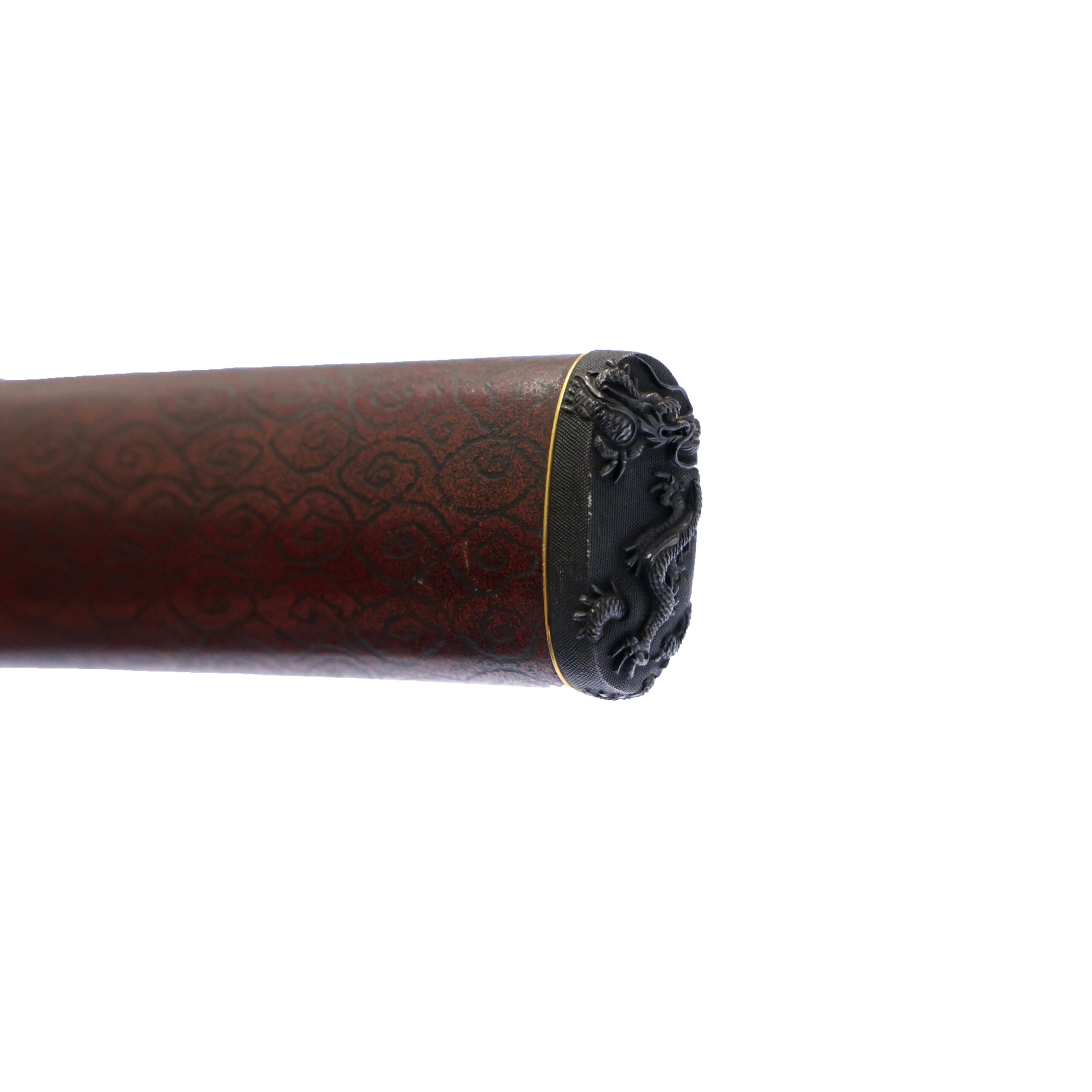
Authentication Paper:NBTHK Tokubetsu Hozon Certificate for the blade (No. 1021973)
NBTHK, also known as Nihon Bijutsu Touken Hozon Kyokai (the Society for the Preservation of the Japan Art Sword), is one of the oldest Japanese sword appraising organizations in modern-day Japan. They authenticated the blade on Feb 21st in the 6th year of Reiwa (2024). They appraised it as Tokubetsu Hozon Touken, the blade especially worth preserving for Japanese society. The purchaser will receive this original certificate as well. We can also translate what is written into English and make a PDF file for your record if you request.
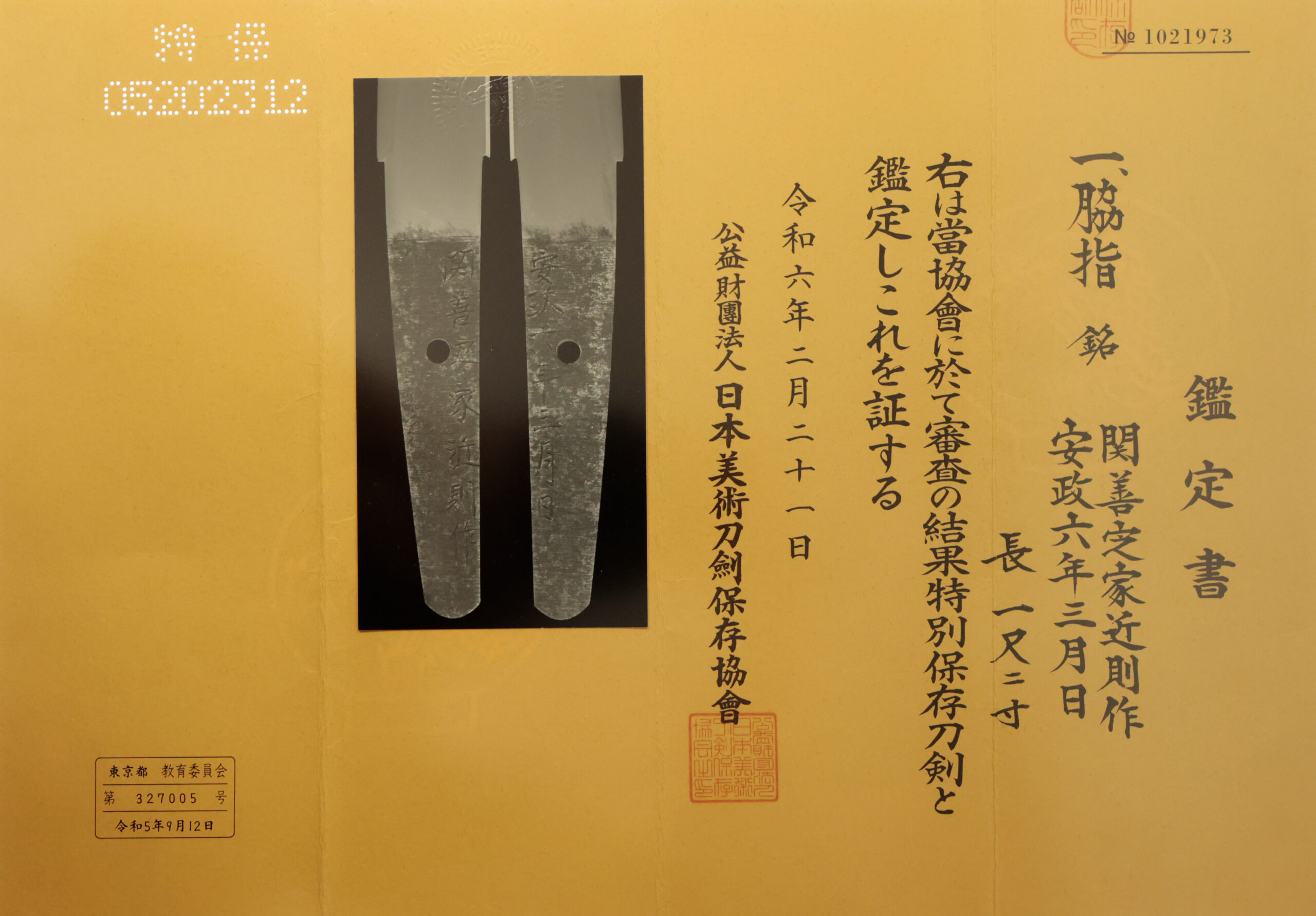
Registration Number : Tokyo 327005
The Board of Education in Tokyo issued a registration paper for this sword. It is called Jyu Token Rui Torokusho (銃刀剣類登録証). Bunkacho (The Agency for Cultural Affairs) acknowledges a Japanese sword with this paper as a work of art.
The sword needs to be traditionally hand-forged and made of Tamahagane carbon steel to be registered in the system. With this paper, its owner in Japan can legally own an authentic Japanese sword. Based on this registration number, we will apply for its export permit.
This paper will need to be returned to the board of education when the sword is being shipped abroad, but you can receive a copy of it. An English translation of this registration paper is available on request.


—————————————————————–
【About us】
Samurai Museum is located in Tokyo, Japan, exhibiting antique artifacts related to the Samurai history. Samurai Museum Shop is the place for those who are interested in Japanese culture and craftsmanship. We deal with antique Samurai swords/armor, traditional crafts made in Japan and so on.
【Japanese Sword& Export Process】
The Japanese swords we deal with are hand-forged edged swords made in Japan. It was made from the traditional carbon steel called TAMAHAGANE(玉鋼). Samurai Museum is familiar with the proper legal procedure for an antique/ authentic Japanese sword to be exported from Japan. We have sent more than 700 Japanese swords for the past few years (~2024) to amazing owners who appreciate its historical value.
Each Japanese sword is registered under the Agency for Cultural Affairs and the Board of Education in Japan. They issue a registration paper for each Japanese sword for its owner in Japan to legally possess it. The Japanese sword with its registration paper means it was traditionally hand-forged in Japan.
To legally export the sword from Japan to other countries, we will have to apply for its permit to the Agency for Cultural Affairs(Bunkacho) and return the original registration paper to the Board of Education. It normally takes around 2-4 weeks to receive this permit after submitting required documents. And we would like you to expect at least 1-1.5 months for your order to arrive at your given address after you ordered. For more detailed info, please click here.
It is allowed for residents in Japan to own authentic Japanese swords without a special license as long as they come with registration papers. Please feel free to contact us if you are a resident of Japan, whether temporarily or permanently. We will also assist you when you leave Japan and need to obtain the export permit.
【Payment Method】
We accept payment through Stripe (Credit card), PayPal, Apple Pay or ChromePay, all of which are secure payment methods. Also, you don’t need to make an account on Stripe for the checkout. If you prefer other payment method, please contact us. After confirming your payment, we will apply for an export permit. You may either pay in JPY, USD, AUD, CAD,EUR CHF or GBP. The price is set in Japanese Yen. Prices in other currencies are automatically calculated based on the latest exchange rate.

* If the amount is above 1 million JPY, Stripe or wire transfer will be the only options for payment.
【Shipping】
We have shipped authentic Japanese swords to the USA, Canada, Mexico, Germany , Belgium, France, Finland, Hong Kong, Australia. If you don’t live in these countries and like to order, please contact us first before making a purchase. We offer Free International Shipping as long as we can send antique Japanese swords by EMS.
We normally ship by EMS(Express Mail Service) provided by Japan Post. We will send you a tracking number for your order as soon as we hand it to the post office. We will put 100 % insurance on the shipping document without any extra charge. Based on the total amount, there might be a duty tax or other fee for you to pay, depending on the countries. We use package cushioning to protect the item and put it in a PVC pipe, which is one of the most secure packages because of its durability.
It will normally takes 5-14 days for the item to arrive at your given address after we dispatch it. Time of delivery is estimated as accurately as possible by the carrier but does not take into account any delays beyond our control such as by inclement weather, post office holiday seasons.
* If you live in Australia and like to purchase an authentic Japanese sword, please click here to know the detail.
* If you live in the UK and like to purchase an authentic Japanese sword, please contact us first and click here to know the detail.

【Review】
Here is one of the reviews we received from a customer who purchased an authentic Japanese sword from us. For more reviews, please click here.
“My experience overall with the whole process was wonderful. I had many questions about the history and process to purchase these treasures. All my questions were answered very timely and complete. The staff is very knowledgeable and very well versed if any questions do arise.”
【How to make sure the condition】
Please keep in mind that what you are going to purchase is an antique item. We uploaded high resolution photos for you to check its condition thoroughly. If you like to see more photos with different angles, please feel free to contact us. We will be happy to send them to you so that you can make informed decision. It is essential for us to know that you are happy with your choice of a sword. and we are prepared to use the best of our ability to serve you.
【How To Contact Us】
Please contact us through email, Facebook Messenger or Live Chat if you have any questions. You can find each icon on the right side of the website. Please click one of them to reach us. We will reply to you within 1-2 business days.
【The Art of Nihonto (Japanese Sword)】
Samurai’s history is a profound, eloquent legacy of ancient Japanese warriors in which millions of people worldwide are being fascinated. If you like to find out the art of Nihonto, please click here.
【A Guide to Japanese Sword Maintenance】
After acquiring an genuine Japanese sword, it is also important to know how to take good care of it. Here is the special video for you. Mr. Paul Martin, Japanese sword expert, shows you how to give proper maintenance to your sword. By mastering how to clean the Japanese sword, its aesthetic beauty will last forever.
When you purchase a Japanese sword from us, you can get a Free Japanese sword maintenance kit. It comes with four tools(Choji Oil, Uchiko Whetstone Powder, Peg remover, Oil Applicator). By watching the video instruction above , you can enjoy learning how to maintain your Japanese sword while appreciating it. If you have any difficulty assembling the sword or cleaning the blade, you can feel free to contact us.
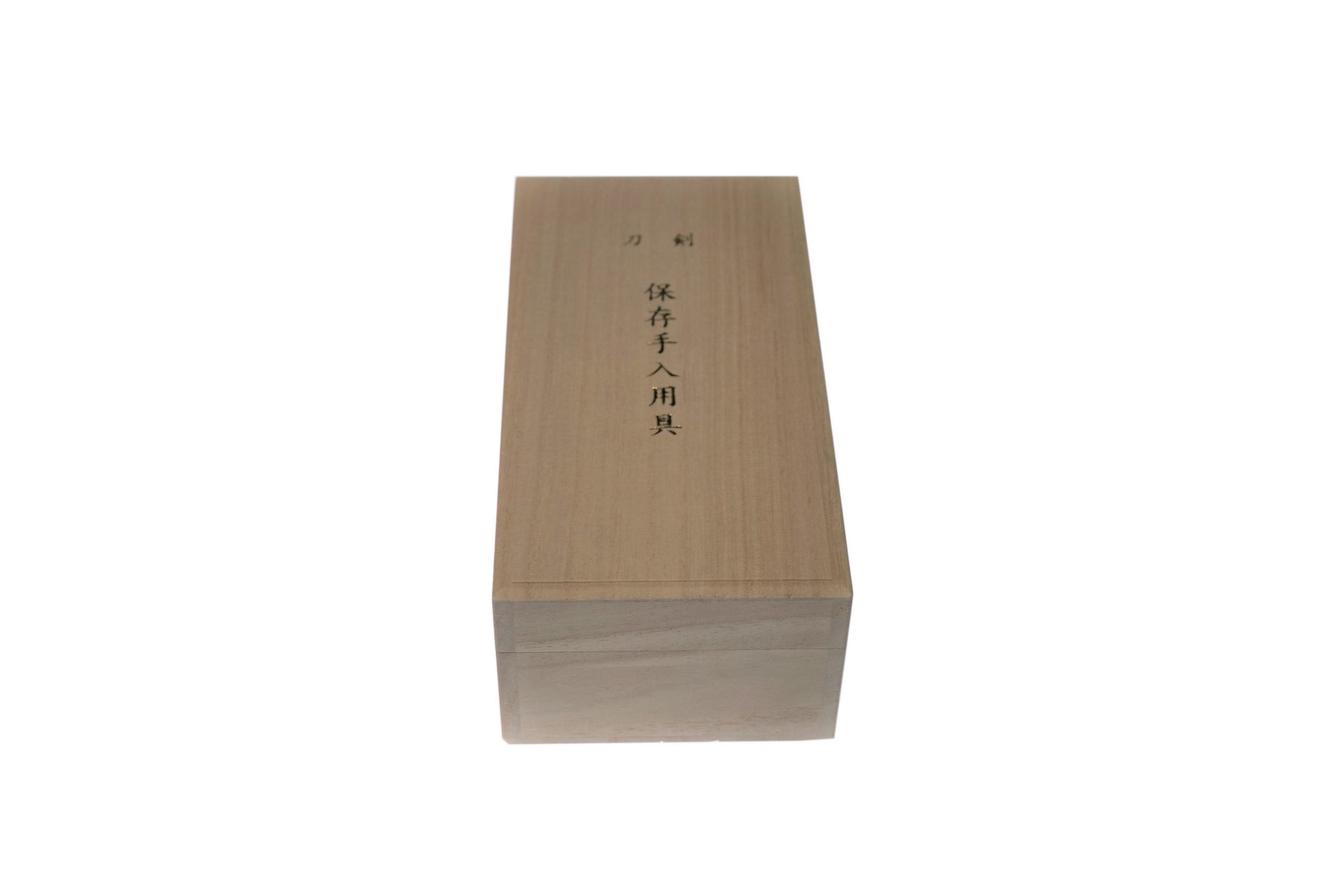
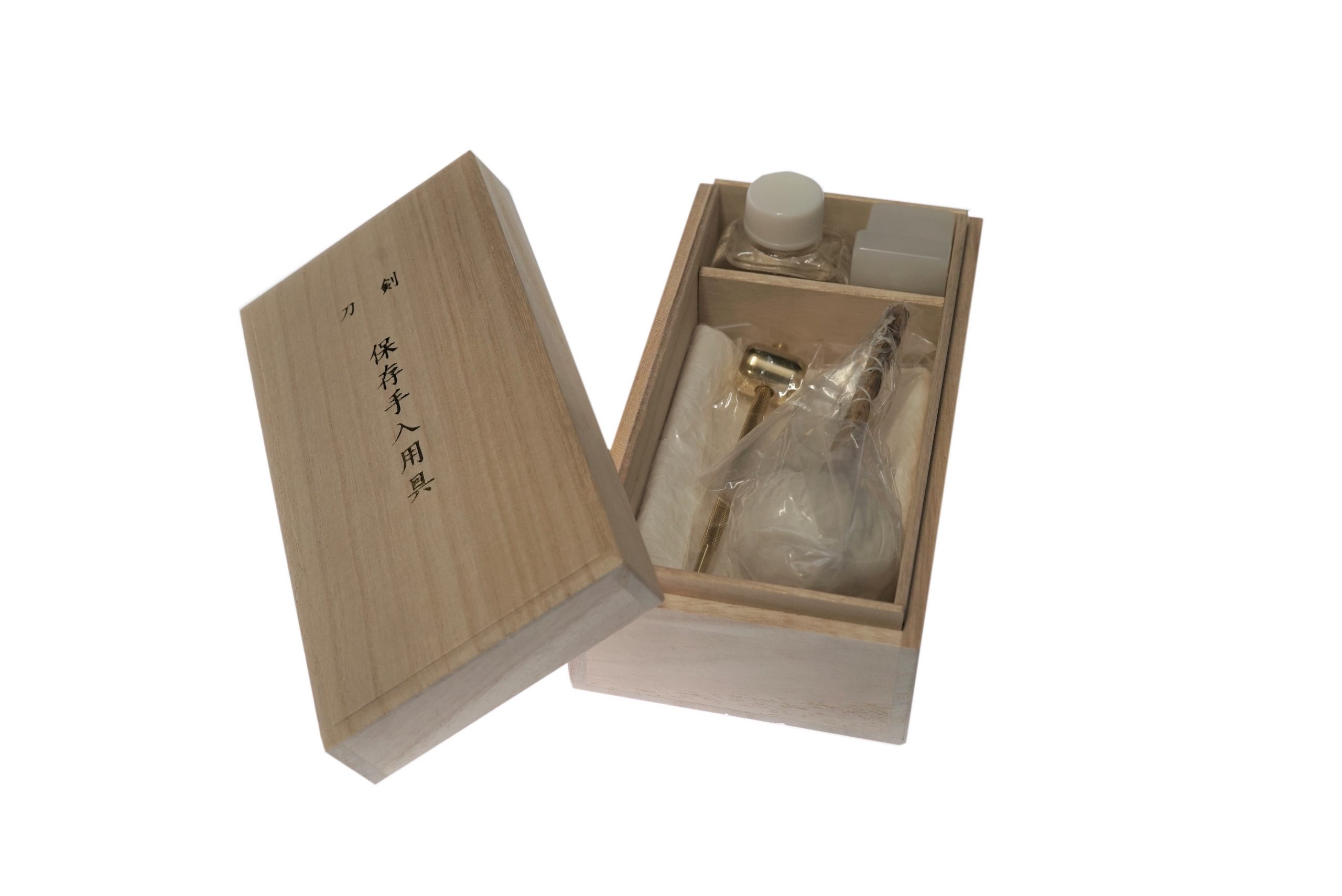
MORE ANTIQUE JAPANESE SWORD FOR SALE
SWORDS WITHOUT CERTIFICATES FOR SALE
LEARN JAPANESE SWORD TERMINOLOGY
Thank you for reading all the information on the page. If you have any difficulty choosing the right Japanese sword for you, we will be more than happy to help you find the one that speaks to you the most. Please feel free to contact us.
